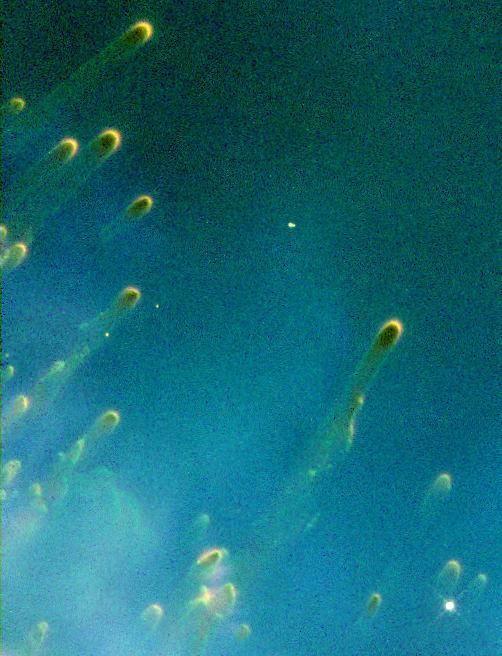 | ||
Cometary knots are structures observed in several nearby planetary nebulae, including the Helix Nebula (NGC 7293), the Ring Nebula (NGC 6720), the Dumbbell Nebula (NGC 6853), the Eskimo Nebula (NGC 2392), and the Retina Nebula (IC 4406). It is believed that they are a common feature of the evolution of planetary nebulae, but can only be resolved in the nearest examples. They are generally larger than the size of the Solar system (i.e. the orbit of Pluto), with masses comparable to that of the Earth. The knots represent "the ionized 'skin' of a dense, dusty molecular globule" that forms a crescent-shaped structure where it is ionized and illuminated by the central star, with a trailing spoke or tail. The central globule is at least 1000 times denser than the surrounding material that streams past it. The appearance is analogous to the tail of a comet that faces away from its star, but comets are solid bodies and much smaller in overall size and mass.
Contents
On the near side of the Helix Nebula, the central dusty globule of each cometary knot appears dark against the background of a central spherical shell that emits [O III] 5007 Angstrom light. Those on the far side do not obstruct this light source and so do not have this dark appearance.
Relation to other photoevaporation flows
Cometary knots are one type of ionized photoevaporation flow, which is characteristically associated with planetary nebulae, but several other types of photoevaporation flows (proplyds, cometary globules, elephant trunks, and champagne flows) are known from H II regions such as the Orion Nebula. Cometary knots are described as more advection-dominated than the other varieties, which are recombination-dominated or dust-dominated. The distinction can be made in terms of the formula for the "dynamic ionization balance within a photoevaporation flow", F* ≈ μn0 + αn02h. Here F* is the "ionizing photon flux incident on the outside of the flow", μ is the "initial velocity of the flow", α is the "recombination coefficient", n0 is the "peak ionized density in the flow", and h, which is approximately 0.1 r0, is the "effective thickness of the flow". In advection-dominated flows, μn0 is greater than αn02h, and most of the incoming photons reach the ionization front and ionize fresh gas. In other flows, most photons fail to reach the ionization front, and instead balance recombinations in the flow.
Reports in more distant objects
Several structures have been described as cometary knots or cometary globules that surround R Coronae Borealis, which is a peculiar star described as potentially the result of a white dwarf merger or final helium shell flash that periodically dims due to a build-up of carbon dust surrounding it, acting as a 'natural coronograph'.
Three-dimensional modelling of NGC 6337, a planetary nebula with a close binary nucleus, suggests the presence of a "thick ring with radial filaments and knots." The cometary knots represent large density fluctuations in a slowly expanding toroid.
